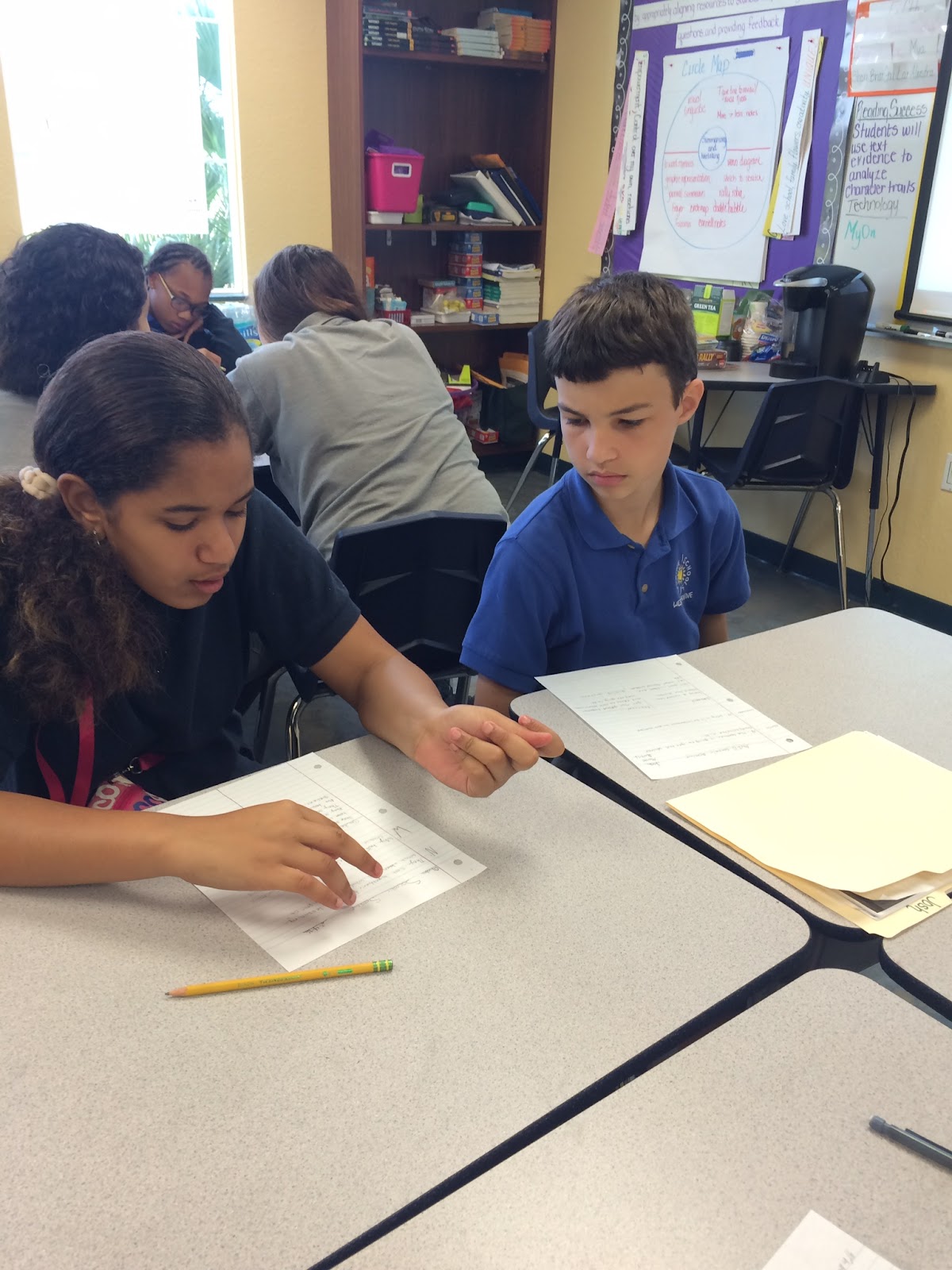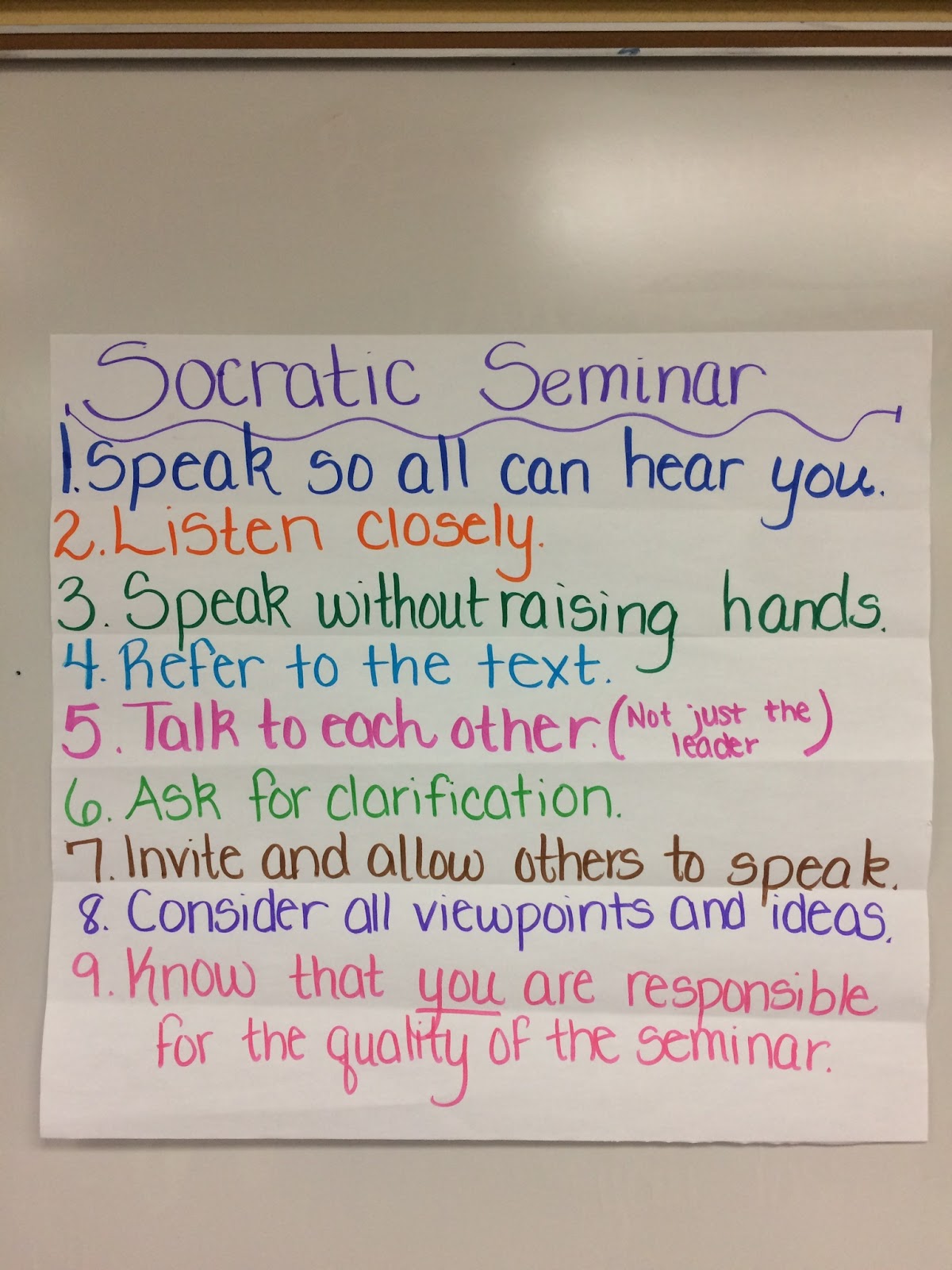As you may have heard I am on a kick with Socratic Seminars. I love this strategy! It's so purposeful, allowing the students to take ownership of their text based conversation, leaving the teacher merely as a guide to set the stage for success. The students are responsible for facilitating a discussion around ideas in the text through listening, making meaning, and finding common shared understanding.
Below you will find the process Ms. Hodkinson and I went through this week for 5th and 6th grade:
Step One: Selecting appropriate texts.
Socratic seminars are based on close textual analysis so it is important to select a text that provides avenues for interpretation and discussion. I decided to choose two texts since we are working on comparing two texts in 5th and 6th grade. I chose two different texts on Amelia Earhart; One text is organized as a readers theatre, while the other shows an obvious bias of how her actions lead to her...disappearance. We read each text closely coding and highlighting different metacognition stems. After reading each text they were responsible for comparing the texts and determining character traits that Amelia possessed that made her the “sassy” pilot she was.
Step Two: Students prepare for the Seminar
Before beginning the seminar, it is essential that students have time to prepare ideas. The students have carefully annotated the text, but I also needed to make sure they were prepared for the actual structure of a Socratic seminar. So I showed this short five minute video showcasing a middle school class conducting Socratic Seminar. While they were watching they had to “code” the video with what they Notice, Wonder, and make a T chart with Teacher Responsibilities and Student Responsibilities.  After the video they shared what they noticed with their shoulder partner, and wow did I love these discussions.
After the video they shared what they noticed with their shoulder partner, and wow did I love these discussions.  To hear a student who struggles with being engaged say, “ I noticed the students took ownership of the conversation and the teacher was just listening.” Moments like that is why I love teaching. I of course told him to kiss his brain.
To hear a student who struggles with being engaged say, “ I noticed the students took ownership of the conversation and the teacher was just listening.” Moments like that is why I love teaching. I of course told him to kiss his brain.
Step Three: Contracting
Socratic seminars have rules that may not apply to other forms of discussion, so before beginning the seminar, it was important to talk not only share the Ground Rules, but also to have the students notice how they are different than our normal classroom norms.  They were pretty stoked about Rule # 3 , No raising of hands. I also made sure to emphasize the last rule. That it wasn't the teachers’ Socratic Seminar, this is YOUR discussion with your peers; the success relies on you as a engaged, participating student.
They were pretty stoked about Rule # 3 , No raising of hands. I also made sure to emphasize the last rule. That it wasn't the teachers’ Socratic Seminar, this is YOUR discussion with your peers; the success relies on you as a engaged, participating student.
After norms were established we handed out their “guide”. The students responded to the guiding question, then wrote their own follow up question to pose to their classmates during the seminar. The next step was reviewing observing their peers, then choosing three stems they are going to use during their Socratic seminar. Finally, they shared their hopeful stems to their partner before the Socratic Seminar began. This allowed the students to hold each other accountable and give their partner a heads up on what they were listening for.
Step Four: The Socratic Seminar
A Socratic seminar often begins with the discussion leader, a student or the teacher, asking an open-ended question. So I have chosen to pose the question myself being that this is their first seminar. I know that silence is ok and expected it. I am quite comfortable with uncomfortable silence due to wait time, however this put a whole new definition to wait time. I really wanted to jump in, but I restrained myself knowing that eventually they will get uncomfortable and talk. Finally after approximately 2 minutes the conversation was happening, however it wasn't until probably 7 minutes in was it really flowing. The students were responding to one another and referring back to their text heavily. About ¾ of the way through it seemed to be turning more towards a debate which I wanted to guide more towards a conversation, so I asked a question to switch gears. By the end of the inner circle Socratic seminar, our discussion had turned into a conversation about men and women stereotypes, yet, somehow the students kept referring back to the text and Amelia Earhart. WOW. This was powerful. After the inner circle discussion was over we had the students commend each other for their stems and input in the discussion. 
After the partners shared, our next step was to reflect on what all students noticed about the inner circle. I was pleasantly surprised at their responses, knowing that this reflection would set up by outer circle for even further success. The outer circle’s discussion was even better, I am sure due to the fact that they got to see their peers participate first. We actually had two students so into from the outer circle that they scooted their chairs up into the inner circle to wait for their turn to add a viewpoint. Is it wrong that I didn't stop them? I wanted to cry happy tears of the ownership of the conversation that was taking place, so I chose not to interject. If you would like to see a sneak peek of our Socratic Seminar click here!
Step 5- Reflection and Evaluation
After the Socratic Seminar, students should be given the opportunity to evaluate the seminar as well as their own participation in the seminar. We first had the students reflect on their thinking and if it had changed after the socratic seminar. The students wrote their responses reflectively in their guides first, then reflected with their partners. Again, I was pleasantly surprised with the rigor of the content within their discussion. Our next step in the reflection process was to discuss as a team what went well and what we can next time to grow and make our socratic seminar better. The students had time to think about it, write about it, talk about it with a partner, then we made an anchor chart. We will revisit this anchor chart prior to our next socratic seminar. The words “ you told me _____” can be quite the powerful tool! Lastly, the students compiled a list of items that interest them, that they would like to speak about. What a better way to get students to take ownership than allowing them to choose the topic of the text and conversation!
For more information on Socratic Seminars check out this helpful educator site!
Step 6- My Reflection
After any new teaching strategy it is crucial to reflect on the strategy and how the implementation supported or did not support the students success. I felt it went really well for my first Socratic Seminar! The students were engaged, referring back to the text, speaking respectfully to their peers, as well as stayed on topic the entire time. Next time, I will set up the speaking stems a little bit better, I want to make sure they understand this is a conversation and not a debate. Overall, the strategy aligned with speaking, listening, writing, and reading standards that the students excelled at. I look forward to our next Socratic Seminar!For more information on Socratic Seminars check out this helpful educator site!
How can you use Socratic Seminars in your classroom to drive discussions, improve discourse and collaboration and deepen understanding through critical thinking?